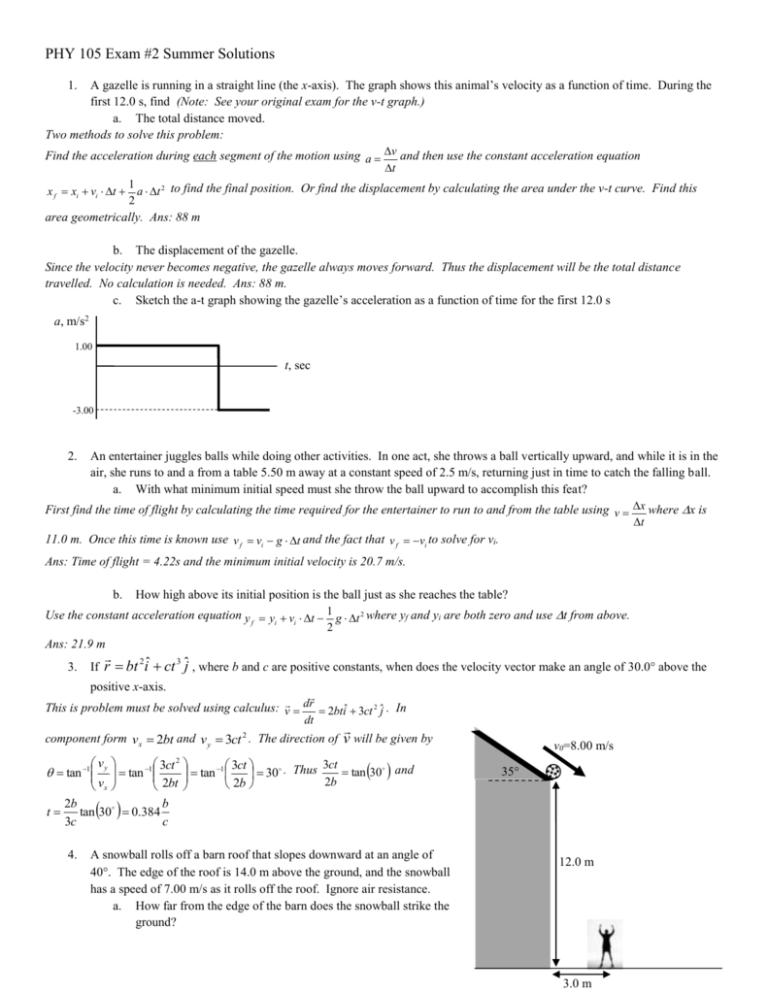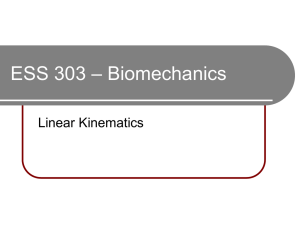PHY 105 Exam 2 Summer Solutions - Physics Problems
advertisement

PHY 105 Exam #2 Summer Solutions A gazelle is running in a straight line (the x-axis). The graph shows this animal’s velocity as a function of time. During the first 12.0 s, find (Note: See your original exam for the v-t graph.) a. The total distance moved. Two methods to solve this problem: 1. Find the acceleration during each segment of the motion using a v and then use the constant acceleration equation t 1 2 to find the final position. Or find the displacement by calculating the area under the v-t curve. Find this x f xi vi t a t 2 area geometrically. Ans: 88 m b. The displacement of the gazelle. Since the velocity never becomes negative, the gazelle always moves forward. Thus the displacement will be the total distance travelled. No calculation is needed. Ans: 88 m. c. Sketch the a-t graph showing the gazelle’s acceleration as a function of time for the first 12.0 s a, m/s2 1.00 t, sec -3.00 2. An entertainer juggles balls while doing other activities. In one act, she throws a ball vertically upward, and while it is in the air, she runs to and a from a table 5.50 m away at a constant speed of 2.5 m/s, returning just in time to catch the falling ball. a. With what minimum initial speed must she throw the ball upward to accomplish this feat? First find the time of flight by calculating the time required for the entertainer to run to and from the table using v x where x is t 11.0 m. Once this time is known use v f vi g t and the fact that v f vi to solve for vi. Ans: Time of flight = 4.22s and the minimum initial velocity is 20.7 m/s. b. How high above its initial position is the ball just as she reaches the table? Use the constant acceleration equation y f yi vi t 1 g t 2 where yf and yi are both zero and use t from above. 2 Ans: 21.9 m 3. 2 3 If r bt iˆ ct ˆj , where b and c are positive constants, when does the velocity vector make an angle of 30.0 above the positive x-axis. This is problem must be solved using calculus: v dr 2btiˆ 3ct 2 ˆj . In dt component form v x 2bt and v y 3ct . The direction of 2 v will be given by v 3ct 2 3ct 3ct tan 30 and tan 1 tan 1 y tan 1 30 . Thus 2 b v 2 bt 2 b x 2b b t tan 30 0.384 3c c 4. A snowball rolls off a barn roof that slopes downward at an angle of 40. The edge of the roof is 14.0 m above the ground, and the snowball has a speed of 7.00 m/s as it rolls off the roof. Ignore air resistance. a. How far from the edge of the barn does the snowball strike the ground? v0=8.00 m/s 35 12.0 m 3.0 m Find the time of flight using y f yi v y ,i t 1 g t 2 where vy ,i v0 sin 35 . Unfortunately this involves solving the quadratic 2 equation. Ans: Time of flight = +1.16 s Now use the horizontal constant velocity motion to find the range x f xi vx ,i t where vx,i v0 cos35 Ans: The snow ball hits the ground 7.63 meters from the barn. b. Draw x-t, y-t, vx-t and vy-t graphs. 12.0 7.63 x, m Parabolic y, m Slope = 6.55 m/s 1.16 t, sec vx, m/s t, sec 1.16 vy, m/s 1.16 t, sec -4.59 6.55 t, sec 1.16 c. A man 1.9 m tall is standing 4.0 m from the edge of the barn. Will he be hit by the snowball? To solve this problem you need to find either the height of the snowball when x = 3.0 m or the distance of the snowball from the barn when the height is 1.5 m. Either way, you first find the time of flight and then calculate the position. Ans: The time of flight for x to equal 3.0 m is 0.458 s. This gives a height of 8.86 m at that time. Since the man is only 1.5 m tall, the snowball passes far over his head. A miss! 5. An airplane pilot sets a compass course due west and maintains an airspeed of 220 km/h. After flying for 0.500 h, she finds herself over a town 120 km west and 20 km south of her starting point. a. Find the wind velocity (magnitude and direction). This is a relative velocity problem with a twist. The twist being that you are given the velocity of the airplane respect to the air and . You need to convert the displacement into a velocity or the velocity into a E displacement. The simplest solution is to convert the velocity of the airplane respect to the air v p into a displacement over the a 0.5 hour time interval. That conversion leads to rp 100 km, 0 km . Note: I a rp assume that the positive x-axis points East and the positive y-axis points North. Now you it’s displacement with respect to the Earth rp can construct the vector diagram and write the vector addition relation. v p v p va E a ra a E rp E E Solve this vector equation for va using va v p v p E E E a v p - 120 km, - 30 km E Now simply calculate the magnitude of the air ‘s velocity with respect to the Earth and its direction. v p - 100 km, 0 km a va - 20 km, - 30 km E Ans: The wind is blowing at 72 km/hr in a direction of 56.2 South of West. b. If the wind velocity is 40 km/h due south, in what direction should the pilot set her course to travel due west. Use the same airspeed of 220 km/h. This problem is solved in a like manner. See the vector addition diagram and the vector addition relations below v p v p va E a E a E E v p v p va va v p - v p km/hr, 0 km/hr E E va 0 km/hr, - 50 km/hr E v p - 200 km/hr cos( ), - 200 km/hr sin ( ) vp a E vp E a -vp km/hr - 0 km/hr -200 km/hr cos( ) and 50 km/hr 200 km/hr sin ( ) E These last two equation s can be solved for . Ans: The pilot should set a course for 14.5 North of West. 6. A model of a helicopter has four blades, each 3.50 m long from the central shaft to the blade tip. The model is rotated in a wind tunnel at 575 rev/min. a. What is the linear speed of the blade tip, in m/s? This problem is really a unit conversion problem. You need to convert the rpm’s of this 3.50 the 3.50 m long blade into a velocity at its tip. It’s simple: 575 b. rev rev 60 s 575 min min 1 min m 2 3.50 m 1 rev 210.7 s What is the radial acceleration of the blade tip expressed as a multiple of the acceleration of gravity, g? 2 m 210.7 2 2 v m s Just plug and chug the centripetal acceleration a 12,690 2 . Divide this acceleration by 9.81m/s to get the r 3.50 m s answer. Ans: a = 1,295”g”









